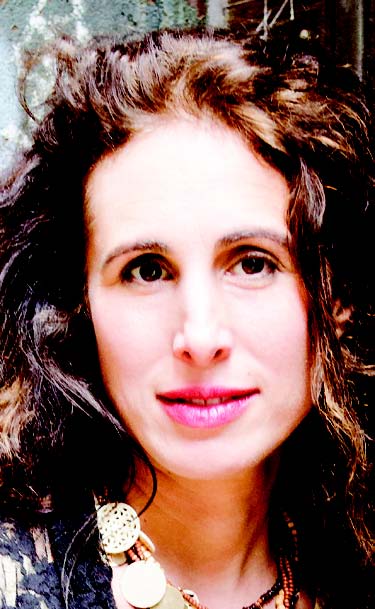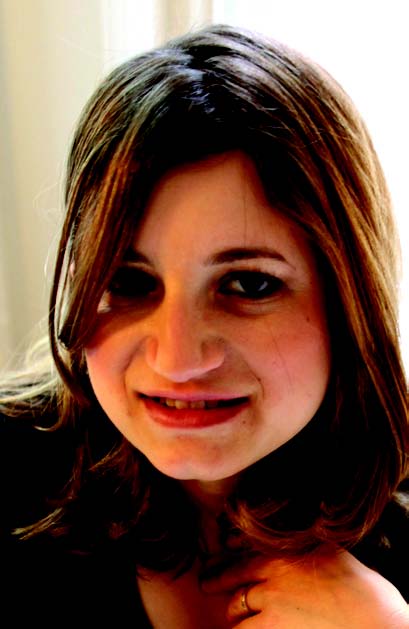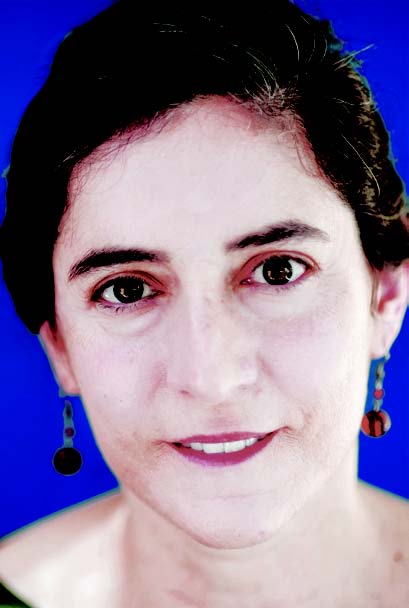lives
THREEPROFILES |
In this issue we look at
|

|
BASYA SCHECHTERThe Music of ExileBasya Schechter was the girl secretly eating non-kosher Cheese Doodles at the back of the Bais Yaakov bus. She was the girl playing “What a Feeling” from Fame and dancing on the roof of the dour, ultra-Orthodox girls’ school in Borough Park, in full view of the Mir Yeshiva next door. The singer-songwriter-guitarist who helms the band Pharaoh’s Daughter, Schechter has always been a pusher of boundaries — subversive but engaged, a rapscallion with a sense of adventure and little faith in institutions. “Basically you learn how to be a loophole jumper,” Schechter told me recently about growing up religious. “You learn to sneak. I was a sneaker from a very early age.” Schechter’s home life was chaotic. When she was nine, her parents divorced and then remarried six months later, only to divorce again. For a few years, Schechter lived with her father, who was “dating until midnight every night.” “I basically brought myself up,” she said. She would pretend to be sick, and when she had the house to herself, she would call television networks — NBC, ABC, CBS — and ask to be on their shows. “I wanted to be a child actress on a soap opera,” she said. When that didn’t pan out, Schechter turned her gaze elsewhere. She started taking classes in performing arts. “I would take five buses and take myself to these dance classes, acting classes.” She was working, too — teaching aerobics, babysitting. “I would make all this money. My father didn’t know what was flying.” It was a coping mechanism Schechter perfected over time: treating her chaotic and often traumatic childhood like an adventure, sublimating her pain and fear so as not to encounter it head on. At seven she had a dream that the eagle of the Biblical prophecy came to take the Jews to Jerusalem and left her behind. It was a formative experience. “It was very clear that I would never have been good enough to travel on those wings to Yerushalayim,” she said. Still, she maintained a constant conversation with God, her spiritual life a child’s response to a half-exasperated, half-bemused authority figure. “The image of God that I always have is of God throwing up his hands and not knowing what the hell to do with me,” she said. Music surrounded her throughout her childhood. Her father, a thwarted musician, would take to the Bima on Shabbos and he would have Schechter accompany him, singing harmony to the liturgical melodies. But he also told her she didn’t have a good voice, and Schechter believed him. At Barnard, Schechter went back and forth on the question of religion. “Am I religious, am I not, am I religious, am I not.” Finally, one night in her last year of college, after eight months of insomnia, Schechter found herself at a diner at four in the morning, when it hit her: “I’m not religious.” And that was that. For awhile, Schechter was a singer-songwriter on the New York scene, her music a far cry from the music that haunted her childhood. But she began to travel. She learned to play the oud. She hitchhiked through Africa, the Middle East, South America. She found herself emotionally awakened by the music of the places she visited, by their traditions of loss and longing. She started writing music that was influenced by these other cultures, by their time signatures and harmonies, and suddenly she found that she couldn’t write in English anymore — it just didn’t fit with the music she wanted to make, and it sounded corny when she tried. Schechter started to look back to the language of her youth, the texts she had grown up with and memorized in her ultra-Orthodox upbringing. Inspired by the longing in the music of other cultures, she started to write music that comes from an idea of galus — exile — “this idea that we’re all yearning and we’re striving; the hardships, the Jewish experience.” It was a paradox. “What brought me back to my own culture, my own heritage, textually, was the influence of music from around the world,” Schechter said. Her records have evolved between forms and languages, expressing different sides of herself at different points along her musical-spiritual journey. “We’re not all one thing,” she explained. “We’re not all spirituality or all rebels. We’re all just trying to figure out how to be authentic.” This tension is a creative, fertile zone for Schechter, though its source is not a joyful one. “If I had had a happy, wonderful childhood, I might have had a happy, wonderful adulthood, but without art.” Now she is the musical director at Romemu, an egalitarian congregation on the Upper West Side. And when she takes the bimah, there or in concert, the woman with the eccentric energy, the self-deprecation, and the childlike smile is replaced by an enchanted woman whose music elicits distant, eastern lands and makes meaning of Exile. ■ |

|
GABRIELLE BIRKNERJournalism as Calling
|

|
ANDREA HODOSDancing at the BoundariesAndrea Hodos, a community based performance artist in Los Angeles, leads workshops that combine movement with textual analysis. After one workshop, she was approached by a participant who said “Oh, I get it! You put the thing next to the thing!” This struck Hodos as an accurate description of what she was trying to accomplish in her work, as an artist and as a religious person. “Art and religion do similar things,” she explained recently on the phone. “They take metaphor and use it to shape the world. I’m interested in that place where art and religion and narrative come together.” Hodos grew up in Western Massachusetts, where, contrary to the joke, there was only one synagogue serving the entire county. No one kept kosher, including the rabbi, who was discovered one night enjoying a lobster dinner. “In my early adolescence, Judaism was about a tribal connection to protect yourself from non-Jews who are out to get you,” she recalled. It wasn’t a model that spoke to Hodos, though when she would ask her parents why it all mattered, they would speak about the importance of community (God wasn’t very much in the picture). “They had a lot of struggles in the community, but they were very committed to it,” she said. Our bodies can teach us things, we can discover things about the text not just by talking about it but by trying to embody it in some way.In college at Yale, something further was lacking. Hodos had danced on and off throughout her childhood, but her interest in narrative made her an outlier. “The theater people weren’t interested in dance and the dance people weren’t interested in theater,” she recalled. She did, however, find nourishment of a different kind when she moved into a house with five other Jewish women, each involved in community service and each at a different level of observance and familiarity with the tradition. One was a labor Zionist who instituted Friday night dinners, and from whom Hodos learned that Kiddush was “more than a one-liner.” It felt like home, and it was a turning point for Hodos with regards to her relationship to her tradition. Her path continued to be shaped by strong female friendships that melded public-service work with the arts and with Judaism. She went with a creative-arts therapy delegation to Nicaragua during the Sandinista period. There she connected with a music therapist who ran a group that focused on authentic movement. Another woman had a Rosh Chodesh group, and they studied the Book of Ruth. It was Hodos’ first time closely reading Jewish texts. After college, Hodos went to Israel to work with the Israel-experience program Livnot U’Lehibanot, and then to study Jewish texts at Pardes, where she realized she was “heir to this incredible legacy of text.” But when the Rodney King riots occurred in Los Angeles in 1992, she felt drawn back to the U.S. “I realized I had not lived Jewishly in America, and I needed to give that a chance, because I cared deeply about what was happening in the States.” Then she discovered Liz Lerman, whose movement-based community building was exactly what Hodos was looking for. Hodos harnessed the tools she learned from Lerman and started applying them to textual study. “Everybody has the ability to be articulate in movement, not just professionals,” she said. “Our bodies can teach us things, we can discover things about the text not just by talking about it but by trying to embody it in some way. And things are more interesting when put together.” She started putting the thing next to the thing. Today, Hodos defines herself as “a Hassidic, halachic egalitarian Jew — dancing at the boundary between the organized and disorganized Jewish communities.” She is a fellow at NewGround, an organization that builds bridges of solidarity between Jews and Muslims based on a common civic vision. Her current projects surround Jewish-Muslim engagement, like Pray With Me, a flash-mob prayer service across Los Angeles, and Sinai and Sunna, a performance-based project that weaves together the stories of religiously or culturally engaged feminists — Jews and Muslims — searching for ways to negotiate the tensions between their religious traditions and the contemporary world. A third piece, “Smart Jewish Woman in Search of Smart Muslim Woman for Conversation and More,” takes place in a Coffee Bean cafe. “I’ve always been fascinated by narrative and what it can do for us,” Hodos said. “Some of that narrative is mythic and some of it is personal. Things for me come down to narrative as healing and elucidating.” ■ Batya Ungar-Sargon is a freelance writer living in Brooklyn. |
| PREVIOUS ARTICLE | NEXT ARTICLE |